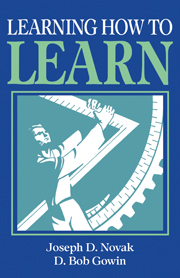Book contents
- Frontmatter
- Contents
- Foreword
- Preface
- Acknowledgments
- 1 Learning about learning
- 2 Concept mapping for meaningful learning
- 3 The Vee heuristic for understanding knowledge and knowledge production
- 4 New strategies for instructional planning
- 5 New strategies for evaluation: concept mapping
- 6 The use of the Vee for evaluation
- 7 The interview as an evaluation tool
- 8 Improving educational research
- Appendixes
- References
- Index
6 - The use of the Vee for evaluation
Published online by Cambridge University Press: 05 June 2012
- Frontmatter
- Contents
- Foreword
- Preface
- Acknowledgments
- 1 Learning about learning
- 2 Concept mapping for meaningful learning
- 3 The Vee heuristic for understanding knowledge and knowledge production
- 4 New strategies for instructional planning
- 5 New strategies for evaluation: concept mapping
- 6 The use of the Vee for evaluation
- 7 The interview as an evaluation tool
- 8 Improving educational research
- Appendixes
- References
- Index
Summary
VALUE AND EVALUATION: WHAT HAS EDUCATIONAL VALUE?
It should be obvious that evaluation rests on the judgment of value. To evaluate, we must have a clear notion of value. Is this piece of knowledge or segment of curriculum valuable? Do this student's claims about this article, this poem, this laboratory, or this piece of mathematics have value? The Vee heuristic is useful for answering these kinds of value questions. Refer again to Figures 1.2 and 3.1 showing the elements of the Vee that, when considered together, function in a normative way to set the criteria of value. A good piece of knowledge should embody all elements of the Vee, illustrate how those elements are connected to each other, and be coherent, comprehensive, and meaningful.
Teachers often struggle with the question, Is this a good lesson? or Is this a good answer to my question? As a normative tool, the Vee tells us that a good lesson, or good answer, should make clear what segment of the world we are dealing with – the events or objects that are of concern – and should show how the other elements of die Vee function integratively to make sense of observations regarding these events or objects. If elements of the Vee are missing or not clear – key concepts or principles omitted; records not clearly linked to the events or objects they describe; principles, theory, or philosophy not stated or implied; claims ambiguously linked to records, principles, and so on – then we can judge that the lesson or answer is faulty.
- Type
- Chapter
- Information
- Learning How to Learn , pp. 109 - 118Publisher: Cambridge University PressPrint publication year: 1984



